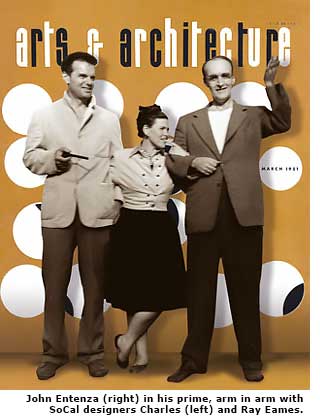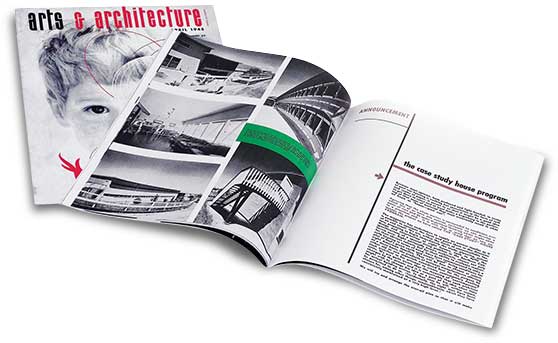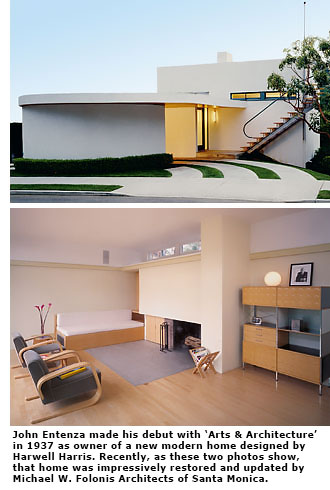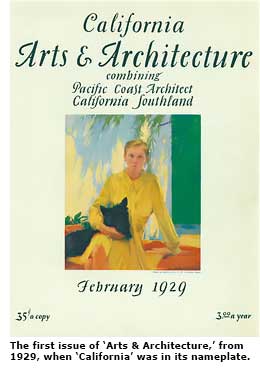Arts & Architecture: Magazine with a Mission
 It was July 1937 when John Entenza made his first appearance in the magazine 'California Arts & Architecture'—not as its editor and publisher, which he would soon be, but as the client for a home designed by architect Harwell Hamilton Harris.
It was July 1937 when John Entenza made his first appearance in the magazine 'California Arts & Architecture'—not as its editor and publisher, which he would soon be, but as the client for a home designed by architect Harwell Hamilton Harris.
"That it be masculine and smart, were the requirements for this beach house for a bachelor playwright," wrote the unnamed narrator—could it have been Entenza himself? "So here it is, as smartly turned out as the season's new cars, and a man's house, every inch of it."
The compact, 850-square-foot house, with flat roof, white stucco walls, metal trim, and touch of Streamline Moderne, was excitingly modern—but so was much else that ran in the magazine in the mid-'30s. In the same issue is a page on Los Angeles modernist architect Rudolph Schindler's McAlmon house and—heading north to 'the Richmond Shore'—a tiny, concrete-block home designed by one of the Bay Area's pioneering modernists, William Wurster.
The rest of the issue is eclectic in the extreme, with its usual classical music and theater notices, art gallery reviews, some traditional houses and one-story ranches "in the California manner," plus a jaunty article by the actor Charles Ruggles—shown with pipe and Sir Woggan, his Beddlington terrier—titled 'Man, his Dog and his Hearth.'
Yet just a few years later—after dropping 'California' from its nameplate in 1944—the monthly magazine would shake up the world as "the mouthpiece for modernist ideas and a platform for the California avant-garde," in the words of historian Pat Kirkham.

It accomplished this, in large measure, because of Entenza's Case Study House program. The Case Study houses were Entenza's bold attempt to remake American residential architecture into something sleek, functional, and largely of glass and steel. In the course of 20 years (1945-1966), the program sponsored the design of 36 homes, most of them in Los Angeles. About two dozen of them were built.

For Entenza (1903-1984), the Case Study program was a crusade. But it was not his first attempt to influence American residential architecture and planning.
Throughout its existence, 'Arts & Architecture' promoted compact, affordable homes; prefabricated homes; well-designed speculative homes for the middle class (by Joe Eichler, Ed Fickett, and others); affordable housing projects for war workers, servicemen, and returning veterans ('25 Experimental Houses for the Federal Works Agency' in April 1942), as well as inner-city slum clearance schemes ('Chicago: a Study of Redevelopment in Action,' 1953).
The September 1940 cover story focused on 'Telesis,' a group of left-leaning architects and planners who "ask the question: Is this the best we can do?"
'Arts & Architecture' was not, like, say, 'Architectural Digest,' about dream homes of the rich and famous. Yes, a 1940 issue illustrated modernist architect Donald Beach Kirby's country home for the Maharajah of Indore. But the classic 'Arts & Architecture' house was elegant but relatively unpretentious, and something that could serve as inspiration for a middle-class home—or even be replicable as such.
Even Entenza's second house, Case Study House 9, by Charles Eames and Eero Saarinen, with its steel-truss frame, expansive living room, two small bedrooms, and one soundproof, window-less, womb-like study, was based on a standardized, replicable plan rooted in a prototype for a 'pre-assembled compact' house that Saarinen designed during World War II as part of Entenza's 'Designs for Post War Living' competition.
The magazine put California architects—including Harwell Harris, Gregory Ain, Henry Hill, Raphael Soriano, John Funk, and dozens more—on the map. "Publication in 'Arts & Architecture,'" wrote David Travers, who ran the magazine after Entenza, "became a door to national and international renown for West Coast architects."

Although the magazine began as a statewide venture, and later became national and even international in scope, it remained in many ways rooted to Los Angeles. Its offices were at 3305 Wilshire Boulevard.
As Travers, who bought the magazine from Entenza in 1962 and ran it until its death six years later, writes, 'Arts & Architecture' was more than the Case Study program.




